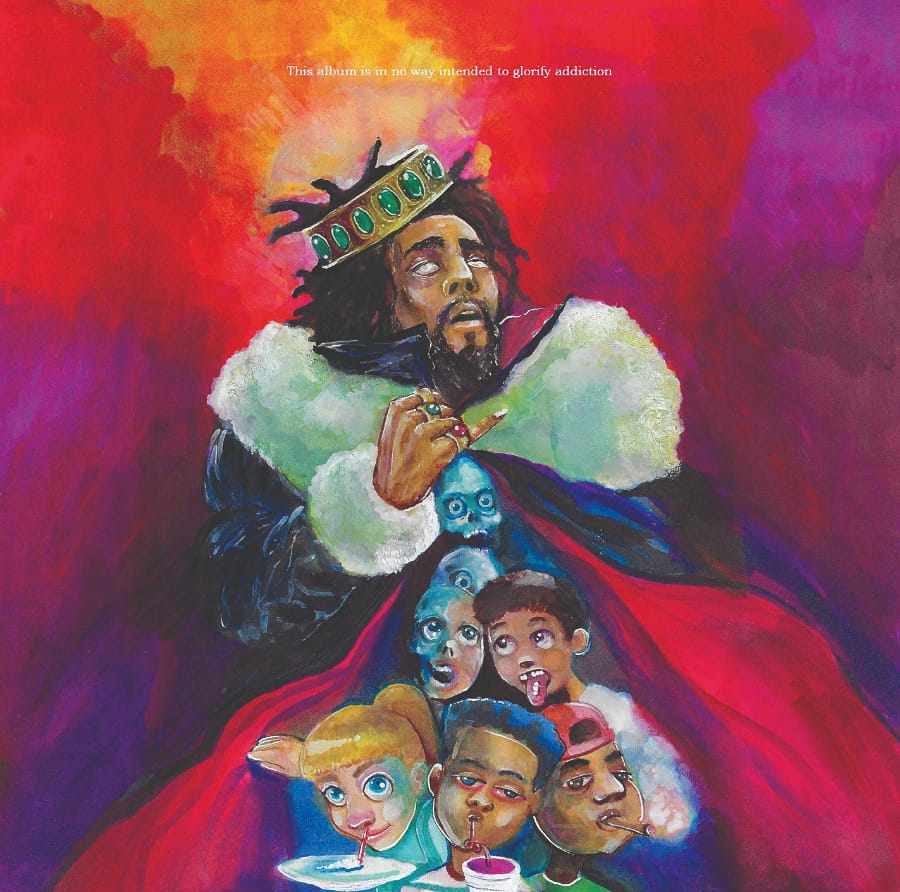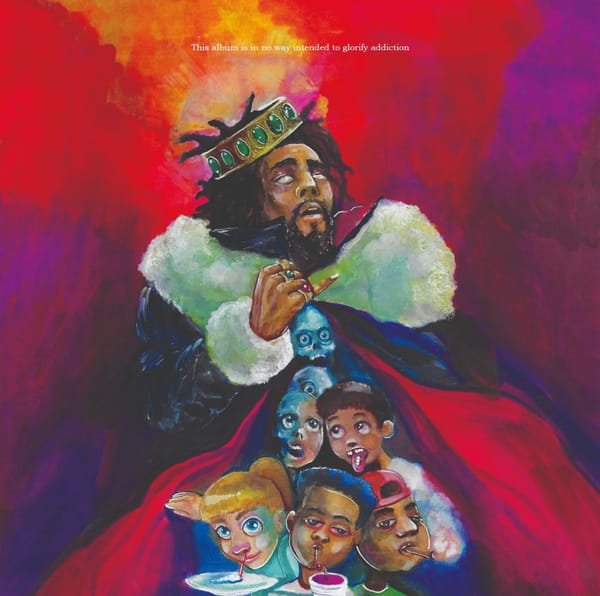The soul of hip-hop: why J. Cole’s status as a member of rap’s elite trifecta can no longer be disputed

J. Cole is often seen as a musician overshadowed by Drake and Kendrick Lamar, but with KOD, his latest studio album, he shows why he’s a vital voice in modern hip-hop. Music writer Jordan Bunke charts his evolution as an artist, and shows why nobody can dispute Cole’s importance as a musician, or the relevance of his work in today’s world.
J. Cole is a singularly intriguing figure in hip-hop. Over the course of his ten-year career, one can observe significant growth in almost every facet of his psyche. Whether it is his relationship with the lifestyle he has dreamt of for so many years, or his musings on his identity as a biracial black man in America, Cole has been on a journey towards finding peace and contentment that can be tracked through each of his five studio albums. With his latest release, KOD, Cole has re-emerged from his self-imposed exile from public life, and instantly made a splash only the likes of Drake, Kendrick, or Kanye could match in hip-hop, all while making an emphatic statement on vices, addiction, and society. While Cole’s music has always included social commentary – on topics ranging from materialism in black America in ‘Chaining Day’ on his sophomore effort Born Sinner to cultural appropriation on 2014 Forest Hills Drive ’s ‘Fire Squad’ – KOD feels like his masterstroke. From top to bottom, Cole sets out with the purpose to start a discourse that promotes introspection, and the execution is nothing short of astonishing. With his fifth album under his belt, J. Cole may have finally climbed out of the shadow that his two juggernaut contemporaries have cast over him for years now.
One of the tracks that best illustrates who J. Cole is as a person is ‘Let Nas Down’, a record that appeared on Born Sinner. The track has Cole recount the discovery that Nas, one of his icons throughout his youth making beats and writing raps in Fayetteville, North Carolina, hated Cole’s breakout single, ‘Work Out’. It is clear that Cole was conflicted about ‘Work Out’ well before he learned that he had disappointed one of his idols. The song is a very accessible radio single geared towards a female audience that has a catchy hook and an interpolation of Paula Abdul’s 1988 Billboard Hot 100 number one smash hit ‘Straight Up’. It was only included on J. Cole’s debut album Cole World: The Sideline Story as a bonus track, and Cole reminisces about his apprehension on ‘Let Nas Down’, citing the song as a necessary evil because the label would only give him a release date with a radio single. The fact that J. Cole recorded ‘Let Nas Down’ shows his integrity and the truth in his art, revealing a profound regret at recording a song that astronomically elevated his profile and led to his debut landing atop the Billboard 200 albums chart upon its release. ‘Let Nas Down’ was a pivotal moment for Cole, as it taught him to never compromise his integrity again.
“J. Cole took a massive gamble with his second album, Born Sinner, changing the release date to coincide with Kanye’s Yeezus”
J. Cole took a massive gamble with his second album, Born Sinner, opting to change the release date to coincide with Kanye West’s Yeezus. After all, Kanye’s status as a hip-hop juggernaut wasn’t cemented until he famously thrashed the seemingly indomitable 50 Cent in a sales battle in 2007. Yeezus did end up outselling Born Sinner in their first week, but only by 30,000 copies – around 10%. Cole’s album proved to have longer legs, however, edging out Kanye for the top spot on the Billboard 200 chart in the third sales week. After this, J. Cole gained greater artistic freedom. His third and most acclaimed album 2014 Forest Hills Drive was released in late 2014 without a promotional single or any featured artists and went on to be certified 2x Platinum by the RIAA in the United States, signifying two million sales. The album was nominated for a Best Rap Album Grammy and spawned hits like ‘No Role Modelz’, ‘Wet Dreamz’, and ‘G.O.M.D.’. J. Cole decided to follow a similar route for his next effort, but 4 Your Eyez Only failed to meet the lofty standards set by its predecessor in the eyes of many fans and consumers. It was around the release of this record that J. Cole quietly welcomed his first child with his long-time girlfriend-turned-wife. The album was hardly promoted, apart from a documentary, and after a few months spent away from his life as a world-famous rapper, Cole leaned on his die-hard fans and still toured very well despite his album’s lack of impact.
And that brings us to KOD. Since 4 Your Eyez Only dropped on 9th December 2016, all Cole had put out is a handful of carefully selected features for the likes of Logic, Joey Bada$$, Royce da 5’9’, and his own Dreamville artist Cozz. On 16th April, Cole simply tweeted: “New album. KOD 4/20”. Within hours, the hip-hop section of the Internet practically melted as speculation began: What does KOD stand for? Why is Cole’s Instagram icon just the colour purple? Without a months-long album rollout, a single, or a stunt, Cole was relevant again. He released the album on 20th April and broke the single day global streaming record for an album on Apple Music, with 64.5 million streams, and the single day US streaming record on Spotify, with 36.6 million streams in the US. While he will undoubtedly perform extremely well commercially given the way the album came out of the gate, that it not why this album is so important to Cole’s status in hip-hop and, ultimately, to his legacy.

Drake, Kendrick Lamar, and J. Cole are often pegged as the three kings of the current generation of hip-hop. All of them came up in the late 2000s and early 2010s, with Drake making a splash on the scene first and Cole and Kendrick hot on his heels. Each have released a classic mixtape that has helped lead to the near-indistinguishable difference between mixtapes and albums today: Drake’s So Far Gone, Kendrick’s Section.80, and Cole’s Friday Night Lights. However, over time, Cole became the dark horse of the trio. Kendrick’s good kid, m.A.A.d city was a critically lauded masterpiece that was celebrated as the triumphant return of west coast hip-hop. It led to one of the most infamous Grammy upsets in recent memory: when Macklemore and Ryan Lewis’s The Heist edged out G.K.M.C. for Best Rap Album. His follow-up, To Pimp A Butterfly, was massively ambitious, preaching pan-Africanism and filled with 2Pac and Jesus allegories. Kendrick came out of the album as a messianic, near-mythical figure for hip-hop whose reputation and status in the game had exceeded that of a mere mortal.
On the other hand, Drake continued to do what he did best: produce ear worm after ear worm and hit after hit. After his 2015 commercial mixtape If You’re Reading This It’s Too Late, Drake had achieved near-global ubiquity. His fourth album Views spawned ‘One Dance’, his first Billboard Hot 100 number 1 hit as a primary artist that became the most streamed song on Spotify (until ‘Shape of You’ happened, that is). With Drake’s status as arguably the biggest name in the entire music industry and Kendrick’s status as the saviour of rap, Cole appeared to be a tier below them. He was categorized as the middle ground: possessing elements of Kendrick’s conscious music without being a revolutionary; being a hitmaker like Drake without tailoring much of his music towards a mainstream audience. Despite consistently releasing quality music, Cole was branded as the boring everyman in the middle of the hip-hop spectrum who continuously failed to seize his potential and join his generational peers among the pantheon of hip-hop legends.
That is no longer the case. With KOD, Cole has shown us exactly why hip-hop needs him. The album is conceptual, but one doesn’t need multiple degrees or hours spent poring over forums to fully decipher its contents like a decent portion of Kendrick’s recent work. Cole’s lyrics are potent. He is an evocative storyteller whose words paint a vivid image in the mind of the listener as he transports them through a myriad of experiences with nigh-cinematic prowess. Whether it is his conversation with a damaged single mother groupie on ‘Is She Gon Pop’ from Born Sinner, or his portrayal of a deceased father leaving a message for his daughter on the title track of 4 Your Eyez Only, Cole has shown time and again that he is unparalleled in this regard. However, this has always been the case.
“Cole is an evocative storyteller whose words paint a vivid image in the mind of the listener”
What sets KOD apart from the rest of his discography is the album’s potential beyond music. Cole’s releases have always been substantive, with tracks highlighting or toying with social issues or aspects of human frailty. Before KOD, Cole has never set out to make a true concept album with such cohesion and effectiveness in its execution. The theme of addiction in its many forms is handled in a manner that people from all walks of life can relate to. Cole does not claim to have all the answers to the issues that he presents, but he still presents some. The album has already begun to spark conversations about infidelity, materialism, alcoholism, drug abuse, the tax system, and a range of other issues. Great art starts conversations, and J. Cole is a great artist. For several reasons, Drake and Kendrick’s music up to this point in their respective careers has not initiated conversations with the socioeconomic reach and openness that this album has and will continue to do. Whether that is because Kendrick is difficult to relate to and not as accessible as J. Cole, or whether Drake’s image makes it hard for him to tackle social issues can be debated, but the prevailing truth is that J. Cole is a necessary staple of the game. Drake, Kendrick, and Cole have been fittingly described as the heart, mind, and soul of hip-hop, respectively, and each of them is a critical component that cannot be overlooked or underestimated.








